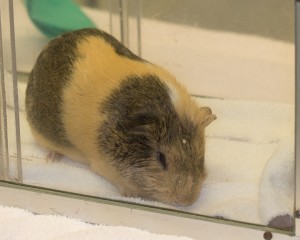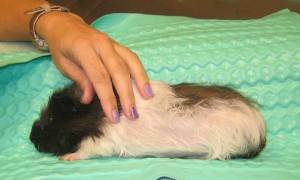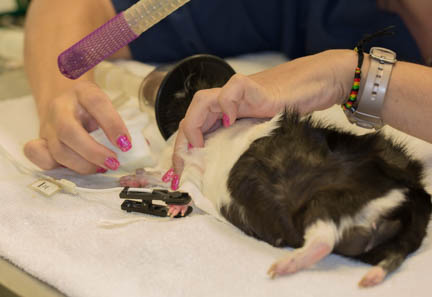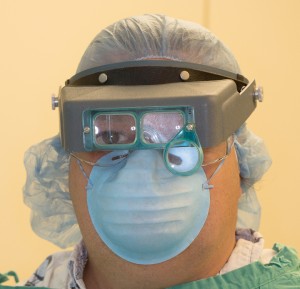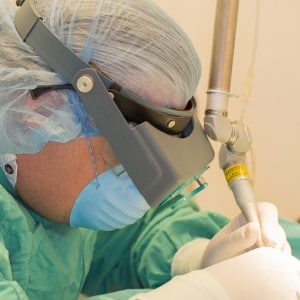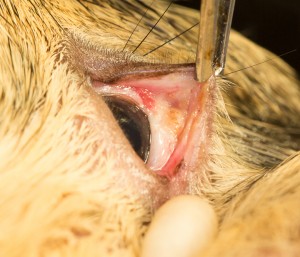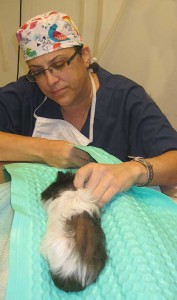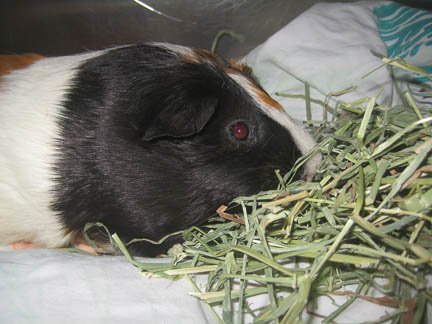This cute little one had a problem with his eye. There was a congenital problem with the hair above the eye. It was overgrown and irritating the cornea.
The extra lash is easily seen on this magnified view
The cornea is the outer clear part of the eye. This extra hair can cause severe problems to the cornea if the problem goes on long enough. There will be a corneal ulcer, which is painful. As time goes on the cornea can become thickened and vision loss will occur. In severe cases the cornea can be perforated from this ulcer and the eye will need to be removed.
The green on this inflamed cornea is fluorscein stain. This is a special stain that shows if an ulcer is present, and how severe it is.
This cornea is scarred and the eyeball is severely inflamed. This eye needs to be removed due to pain and loss of vision.
Due to all these possible complications it is imperative that we take care of the problem as soon as it is diagnosed.
All of our surgical patients are given a thorough exam the day of surgery. Many of our patients are tiny, and we need to pay particular attention to anesthesia.
Here he is starting his anesthesia before surgery
Small animals can lose body temperature easily while under anesthesia, and can become hypothermic. We keep them on a warm water blanket and monitor their temperature during the surgery to prevent this.
All of our Guinea Pigs are connected to instruments that closely monitor important physiological parameters. This one is being connected to a Pulse Oximeter to keep close tabs on oxygen levels and heart rate
This video show how we use it. The number on the left is the oxygen saturation level, the number on the right is the heart rate
We also connect all of our surgical patients to an EKG (electrocardiogram) that is monitored by or Surgical Vet anesthetic monitor.
The SurgiVet Monitor keeps close track of many important parameters
Here it is in action on a different patient
We don’t rely only on hi tech anesthetic equipment, and are hands on at all times in monitoring our patients.
Our anesthetist nurse is monitoring our patient under the surgical drape. She is checking the color of the mucous membranes, along with the heart rate and respiratory rate
While our patient is being prepped for surgery our surgeon is getting the sterile instruments ready.
Now that our surgeon is ready, and our patient is safely under the proper plane of anesthesia, we can begin the surgery
This is meticulous surgery so Dr. Ridgeway needs magnification (he looks like an alien creature)!
Here he is gently pulling up the inside of the upper eyelid to get an idea of how the lash is attached. He will now remove it with our surgical laser.
We use the laser for many reasons. It gently removes the hair, and it does this without any bleeding or inflammation. This is important in this very sensitive area. In the years before we had the laser we used a small scalpel blade. Even though it was a small blade it still caused bleeding and inflammation post operatively.
The laser in action
No more hair, and more importantly to our surgeon, no bleeding or swelling
Lisa keeps a close tab postoperatively to make sure our small patients wake up without any problems
This is how we like to see our Guinea Pigs right after surgery!






